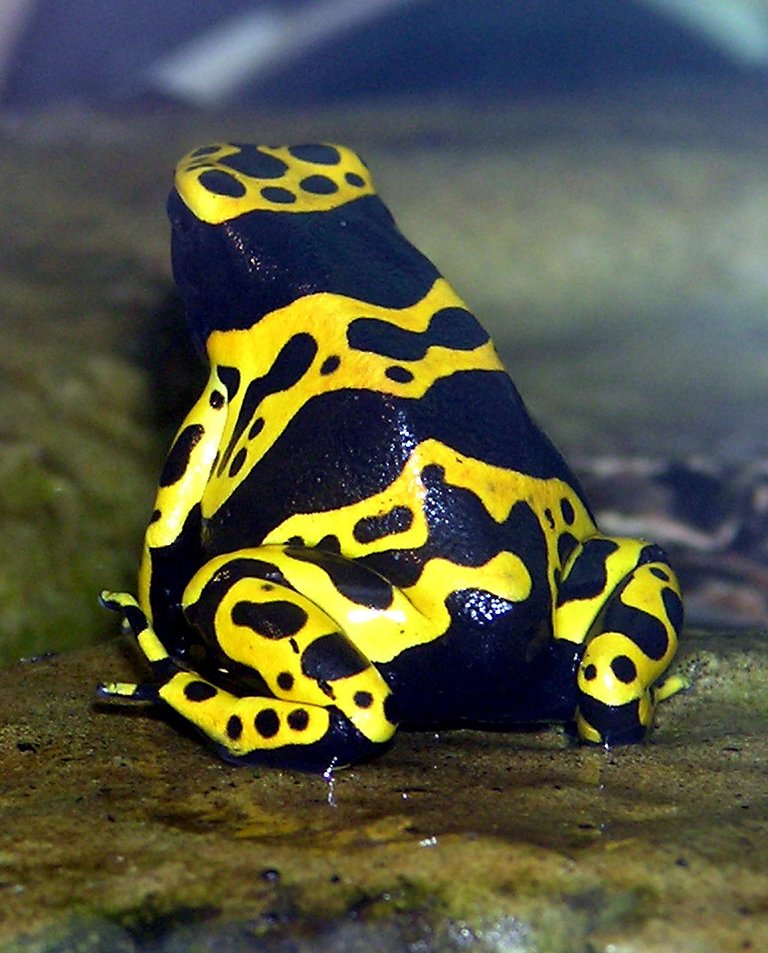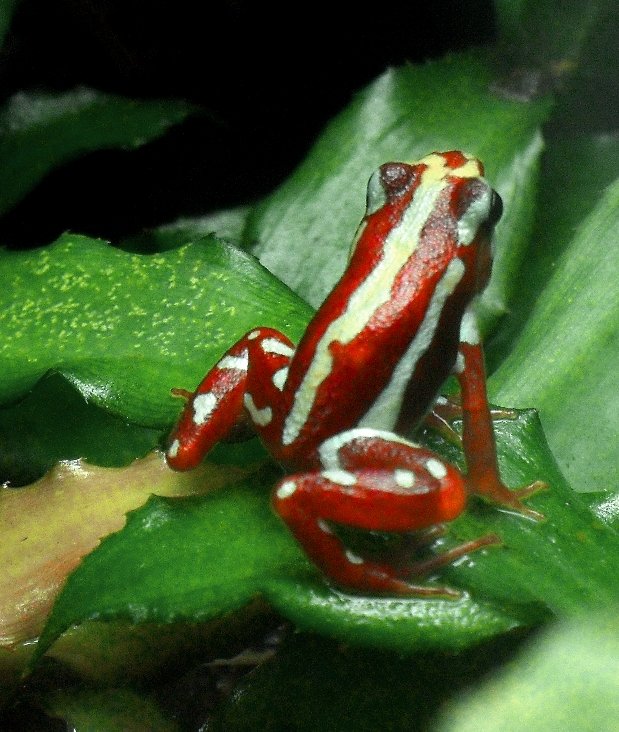The poison dart frogs (Dendrobatidae spp.) is a family of frogs that are well-known for their bright coloration, as well as their toxicity. Their name comes from the fact that some indigenous peoples of the Americas used their toxic secretions on the tips of blowdarts to poison their enemies, and 4 of 170 species have been documented to be used for this purpose.

Dendrobates leucomelas, one of the poisonous dart frogs. Image is posted as public domain.
Many of the poison dart frogs are not really poisonous at all. In fact, a lot of them only have a very low level of toxicity, or even none at all. These frogs typically have a lot more cryptic coloration than their toxic brothers, but some of these can still have colorful skin, probably to scare predators into thinking they are poisonous, an phenomenon known as Batesian mimicry. I have written a post about Batesian mimicry in the past, so make sure to check that out for more information about this phenomenon.
Anyway, let us look to the poison dart frogs that are actually poisonous, and why they are not poisonous in captivity.
The poison of the poison dart frogs
Scientists have isolated 28 different structural alkaloids in the family of poison dart frogs, which they secrete from their skin. This allows the frogs to scare off predators, so they are able to hunt for their own food during the day. This gives them a decent advantage over other frog species, since they tend to rest at day in order to not get eaten by predators.
To give you an idea of how poisonous the frogs can be, take a look at epibatidine. This alkaloid is secreted by Epipedobates anthonyi, and is 200 times more potent than common morphine. Scientists have tried to develop pain killers from this alkaloid, but are having problems with the fact that the fatal dose is too close to the usage dose. This same alkaloid can for sure kill large animals and humans if encountered in the wild, and you do not want to take a bite of this frog!
Epipedobates anthonyi, the frog that secretes the epibatidine alkaloid. Image by Wikimedia user Tubifex, posted with the GNU Free Documentation License.
It is important to remember that this is an extreme case. Most of the poison dart frogs have way less potent toxic, and most would not pose a deadly threat to humans and other large animals.
How the poison dart frogs get their poison
In order for poison dart frogs to be able to secrete poison from their skin, they first need to obtain it. Most other poisonous animals prefer to make their own poison, but the poison dart frogs has an easier way to do it. Instead of making it, they harvest it from ants, mites and termites that they eat. This is known as the diet-toxicity hypothesis, and is mostly based on the fact that captive poison dart frogs are non-toxic.
The exact arthropod species that they eat in order to extract the poison is not entirely known for all the different poison dart frog species, but this will probably be found out in the future as the frogs become more studied. However, leading hypothesis think it might come from termites or ants.
The adaptation to extract poison from their diet is really cool, and without a doubt a nice way to save the energy needed to create their own toxic.
About the author
Hi, I’m @valth! I live in Norway with my girlfriend, our newborn son, and our two dogs, one of which is seen wearing a bow tie in the profile picture!
I am very passionate about nature and biology, and have been studying ecology for a few years now. My passions are mostly within conservation biology, mycology (the studies of mushrooms), animal behavior and general microbiology. I really enjoy both the theoretical aspect, as well as the more practical aspect of biology, and I spend about as much time in front of biology textbooks as I do spend on finding and identifying plant, mushroom and animal species in the forests.
Make sure to hit the big follow button above to go to my profile and follow me! This will make sure all of my posts end up right in your feed, and you can get your daily dose of biology news without any hassle :)


nice post!Thanks
Enjoyed reading this... interesting stuff. Will re-Steemit.
I'm glad you enjoyed it :) Thanks for the re-steem! :D
Interesting read... These frogs look so beautiful!
interesting! thanks for sharing!
magic color
Interesting, amazing post your promotion.
i like Upvote and resteem your post @valth.
Good luck
Theanimal sensational
I remember as a kid I had a few poison dart frogs that I would hold in my hands to my parents dismay. Interesting post thanks for sharing